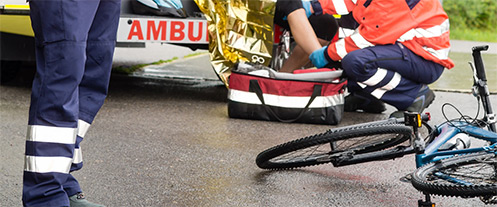Cyclists are vulnerable road users! E.g., a 200-pound cyclist on a bike weighing 50 pounds stands ZERO chance against even the smallest motor vehicle. It’s imperative that cyclists know what to do after a bike crash.
Common Types of Crashes
At KLF we see a range of types of bicycle accidents in the Greater Cleveland area. Most occur at intersections. Common examples include:
• The Left Cross: A left angle crash during which motor vehicle, i.e., car, truck, or SUV, turns left, directly in front of an oncoming cyclist
• The Right Hook, Part 1: A right angle crash during which a motor vehicle passes a cyclist, then turns right directly in front of cyclist
• The Right Hook, Part 2: A right angle crash during which cyclist on the right is passing a slower-moving or stopped motor vehicle on the cyclist’s left, then motor vehicle suddenly turns right, directly into cyclist
• The Rear Ender: Just how it sounds, a motor vehicle crashes into cyclist from behind
Important Steps to Take After a Bike Crash
As a cyclist you need a plan for coping with a bike crash! To that end I’ve created a handy acronym, “P.H.O.N.E.” to help you know the steps to take:
P is for Police: Call the police and insist on an official accident report, no matter what. You need the documentation! Always call the police at the accident scene, even if the motorist begs you not to and/or seems like a saint. (This happens all too often.) Insist, even if the police try to talk you out of it. If you fail to get a police report, the lack of a record and documentation of the crash will cause you later suffering! Some police like to give careless motorists a break and will discourage you from filing a report. If possible, don’t let them! Always request a report with at fault driver cited for appropriate traffic offense.
H is for Healthcare: Seek immediate medical attention for all injuries. If you are hurt, seek emergency medical attention by calling emergency services. Detail all your injuries including minor ones such as cuts and scrapes. Hidden injuries including traumatic brain injuries can quickly become apparent. Now, you can get the medical treatment you need and have the detailed records proving you were injured. Don’t wait!
O is for Observe/Obtain: Get the motorist’s insurance info and exchange contact info. Get names of all witnesses (and witness statements, if possible), or try to make sure the police or other bystanders obtain this vital information on your cell phone. In the event of a hit-and-run driver it will be extremely helpful if your own auto insurance policy has uninsured motorist coverage. If you aren’t sure, check with your insurance provider!
N is for Notification: Call a bike accident attorney (me) for legal advice before talking to the at fault motorist’s liability adjuster. The adjusters are pros for the insurance companies — hire a pro for yourself! The liability adjuster for the motorist is NOT on your side. (They will likely be calling you within 48 hours of the crash.) It’s in their insurance company’s best interest to pressure you for information. Sometimes, even into agreeing to settlement terms that may not even come close to covering all damages. There are also many issues that you won’t know how to handle including insurance coverages, health care and subrogation.
E is for Evidence: Try to document in detail all you can see and recall until police arrive on the scene. Use your cell phone! Also, don’t let the at fault party move their motor vehicle or your bicycle before the police arrive. Look for a building security camera that may have recorded the crash.
Please Note!
Never take any legal steps, e.g., sign or agree to sign a settlement — or do any kind of insurance negotiations at all! — before consulting with an attorney. You may be waiving your right to pursue legal action to recover the full amount for your ongoing injuries. And, you may have to live with your rash decision for the rest of your life.
Property Damage = Evidence
Keep all damaged property including bike frame, ripped clothing and accessories. Do NOT clean or repair them! These items constitute property damage and can be valuable pieces of evidence. Check inside and outside of your cracked helmet for signs of head impact. They may not be remembered or apparent to you right after a crash. In the moments after being hit this can be particularly difficult. But if you’re able, this is an important step.
ALSO: If you have a modern GPS-enabled bicycle computer like a Garmin or a Wahoo, check the data for the actual speed and location of where the crash took place. Tell your attorney if you have a bike computer or a GoPro-type camera. These cameras are a growing trend among cyclists taking additional steps to protect themselves. Non-mandated daytime lights are also being used more frequently by cyclists.
Documentation is Key!
An important step in what to do after a bike crash is keeping a daily journal of symptoms, treatments, days off work, etc. ASAP. This documentation will give your attorney a detailed picture of the careless driver’s impact on your life. Once on a treatment plan such as physical therapy, it’s best to attend all sessions with your medical provider, leaving no “gaps” in your treatment.
Knabe Law Firm has a supply of laminated P.H.O.N.E. business cards to help you remember the important steps to take in the event of a crash. Please contact our office to request a complementary card be mailed to you. The reverse side lists a “Cyclist’s Arsenal” with current Ohio bike laws that all cyclists should have at their fingertips while out on the road.
Take it from an experienced bicycle accident attorney. Know how to cope with a bike crash if one happens. And know HOW they can happen, so you can avoid being in one to begin with!
Ohio cyclists can learn how insurance can help protect them here.

